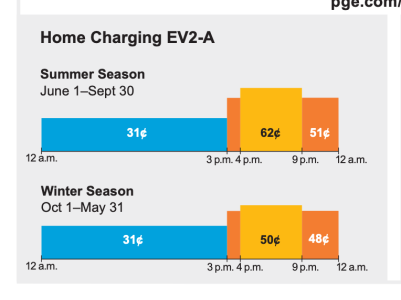No idea what a break-even point would look like after the initial investment,
There isn't a break-even point.
Given 95% charge-discharge efficiency, your spread is 62c*0.95-31c=27.9c for example.
No, the cycle efficiency isn't different between the day / night prices. Also; you calculate the efficiency the wrong way. It's also not 95% by a long shot if you see how hot the charger and battery get...
That means you should expect to use at least 0.4hr per day (either tool or battery-charging), otherwise you're burning the capital for nothing.
You forgot that the 5 Ah battery isn't 1 kWh but actually 0,09 kWh.
But let's assume it takes 0.1 kWh to charge it; you save (62-31)*0.1 = 3.1 cents per day. If the battery lasts 3 years and costs $135, it's fixed cost per day is 12.3 cents, meaning you loose 9.2 cents per day.
But... most recent battery powered tools are way more energy efficient than corded equivalents, so the comparison is still off. If you then have AC in your workshop; you need to add on the AC energy draw for removing the excess heat from the corded tools.
But having said that; if you have really power-hungry tools (the dust extractor to name just one..); replacing that for battery-powered will just result in a pain the a$$ experience for how often you have to change the batteries + the insane initial bill to acquire that many batteries. At that point you need to start comparing to putting the same dollar amount into an index fund.
If I had such a fixed predictable price difference based on time here I would start with my air conditioner, having it cool down 2-3 degrees C more before the higher price hit. But I live on a 30cm concrete floor, below a 20 cm concrete roof and in between 300mm lime-sand brick walls (all within the insulation) that have the very nice property to be able to store an insane amount of thermal energy. The average American home with it's ennobled cardboard walls & ceilings and wooden floor probably doesn't even have a tenth of the thermal mass.
Home batteries are another thing where I live. In some cases it's worth it, but that's mostly around avoiding taxes. Currently; kWhs pushed into the grid (from solar panels) are netted against kWhs taken from the nett and only the result (let's assume the result is still >0) is taxed. That is going to change in the sense that for each kWh taken you have to pay the tax and for each kWh pushed back they give like 0.25 cents per kWh. That means with a home battery you can store excess kWhs that you would otherwise push back in and then when the sun went down you can avoid the tax by draining the battery instead of taking from the grid.
But the home batteries are like €300-400 per kWh and Festool 18V batteries are €1300 per kWh...
If you really want to play here, there are dynamic contracts; a day in advance they publish the kWh price for one hour / 15 minutes (the latter being rather new). This means that on sunny/windy days you can earn 40 cents per kWh you take from the grid (it really becomes 23 cents because of taxes), but it also means you have to pay 40 cents to push one kWh into the grid. On the other side; if it's hot and there is no wind.. when the sun goes down prices might go to 80 cents per kWh for a few hours when everyone (well, especially those with a fixed contract) is cooking, charging their car and running the AC.
If the sun doesn't shine and the wind doesn't blow... it means the gas-powered plants are turned up... but since NorthStream went bo0m... let's just say LNG per ship is not as cheap as piped gas..
Back when the US first got it's shale-gas boom without a means to export... it meant US powerplants with gas where running all the time and the coal plants were turned down. The coal was then exported to Europe and here the coal powered plants ran all the time.
The US under Trump (1st term) warned Germany for getting too dependent on Russian gas, and the German diplomats laughed openly. They don't laugh anymore...
And since the war, some countries have turned their mothballed coal powered plants back on. The Netherlands is one of them. But that action was taken months too late.
We had our gov as part of the election promise give a one-off $100 utility rebate we can start claiming from the end of Aug, yesterday I got the letters from the utility company that from the start of Aug gas+elect is going up $250 year!
Yeah... run up the national debt...
We had energy subsidies for business hit extremely hard by the insane gas prices a few years ago... so basically for businesses that didn't stick to the law in the first place, as they were legally obligated to do all the energy saving measures (that they knew off and) would give a break-even point within five years. That clause 'they know off' means some businesses never want the research into what is possible for them... especially business with American share holders (typically more short-term focused).


